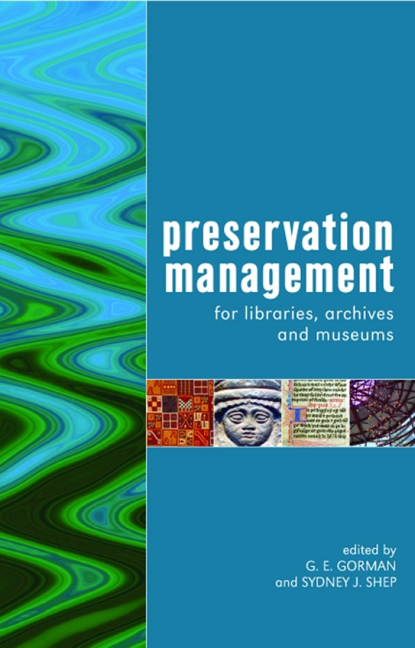Book contents
- Frontmatter
- Contents
- About the contributors
- Introduction
- 1 Managing the documentary heritage: issues for the present and future
- 2 Preservation policy and planning
- 3 Intangible heritage: museums and preservation
- 4 Surrogacy and the artefact
- 5 Moving with the times in search of permanence
- 6 Valuation model for paper conservation research: a new approach for setting research priorities
- 7 Preservation of audiovisual media: traditional to interactive formats
- 8 Challenges of managing the digitally born artefact
- 9 Preserving cultural heritage in times of conflict
- 10 Access and the social contract in memory institutions
- 11 Redefining ‘the collection’ in the 21st century
- Index
4 - Surrogacy and the artefact
Published online by Cambridge University Press: 08 June 2018
- Frontmatter
- Contents
- About the contributors
- Introduction
- 1 Managing the documentary heritage: issues for the present and future
- 2 Preservation policy and planning
- 3 Intangible heritage: museums and preservation
- 4 Surrogacy and the artefact
- 5 Moving with the times in search of permanence
- 6 Valuation model for paper conservation research: a new approach for setting research priorities
- 7 Preservation of audiovisual media: traditional to interactive formats
- 8 Challenges of managing the digitally born artefact
- 9 Preserving cultural heritage in times of conflict
- 10 Access and the social contract in memory institutions
- 11 Redefining ‘the collection’ in the 21st century
- Index
Summary
Introduction
This chapter deals with the relationship between an artefact and different kinds of surrogate representation of that artefact in the digital world. It discusses the difficult problem of the authenticity and authentication of digital data, and some of the technical methods of authenticating data. The use of digital data as a preservation alternative is also dealt with.
With the advent of photographic techniques for copying documents, conservation of the originals became easier. Documents could be, and were, reproduced as facsimiles in books or on microfilm and these were offered to the readers as a substitute for the originals, thus preserving the originals from further damage. The documentary heritage has always been at risk of damage or destruction through natural or human forces: fire, flood, warfare or neglect. In the last 150 years, a new danger has threatened: the ‘“slow fires” of acidic paper’ (Kenney, 1997, 2), which has necessitated the large-scale microfilming of millions of pages of documents over many decades in order that the content is not lost. Many digital reformatting initiatives grew out of earlier microfilming projects, lighting the ‘“fast fires” of digital obsolescence’ (Kenney, 1997, 2).
Substitution of originals with other objects that simulate their content does, of course, pose its own problems: when is a facsimile a satisfactory surrogate for the object itself? This depends on both the needs of the reader and the quality of the reproduction, and is not an easy question to answer. The relationship between any original object and a reproduction of it is problematic, and is a question which has exercised theorists and practitioners of artefactual disciplines for many years. In his seminal essay ‘The Work of Art in an Age of Mechanical Reproduction’, Walter Benjamin states that: ‘Even the most perfect reproduction … is lacking in one element: its presence in time and space. … This unique existence of the work … determined the history to which it was subject throughout its time of existence.’ (Benjamin, 1973 (reprinted 1992), 214).
- Type
- Chapter
- Information
- Publisher: FacetPrint publication year: 2006
- 1
- Cited by



